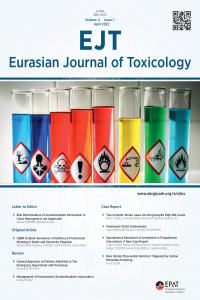Hüseyin ACAR, Mehmet Göktuğ EFGAN, Osman Sezer ÇINAROĞLU, Kadriye ACAR, Serkan BİLGİN, Ahmet KAYALI, Zeynep KARAKAYA
İzmir'de Acil Servise Başvuran Akrep Sokması Olgularının Klinik ve Epidemiyolojik Özelliklerinin Retrospektif Olarak Değerlendirilmesi
Amaç: Bu çalışmanın amacı İzmir bölgesinde 3. Basamak bir hastanenin acil servisine başvuran akrep sokması vakalarının epidemiyolojik ve klinik özelliklerinin değerlendirilmesidir.
Materyal Metot: Bu çalışma, retrospektif kesitsel bir çalışmadır. Çalışmada 2000-2022 yılları arasında acil serise akrep sokması nedeniyle baş vuran hastalar dahil edildi. Hastalara ait demografik ve klinik veriler ile laboratuvar test sonuçları hastanenin elektronik veri tabanında tarandı. Bağımsız iki grup arasındaki farkın karşılaştırılmasında student t test kullanıldı. P
Anahtar Kelimeler:
Akrep sokması, zehirlenme, toksikoloji, epidemiyoloji
Retrospective Evaluation of Clinical and Epidemiological Characteristics of Scorpion Sting Cases Presenting to the Emergency Department in Izmir
Objective: The aim of this study is to evaluate the epidemiological and clinical features of scorpion sting cases admitted to the emergency department of a tertiary hospital in the Izmir province.
Material Method: This is a retrospective cross-sectional study. Patients who applied to the emergency department because of scorpion sting between 2000-2022 years were included in the study. Demographic and clinical data and laboratory test results of the patients were searched through the hospital’s electronic database. Student t test was used to compare the difference between two independent groups. P
Keywords:
Scorpion sting, poisoning, toxicology, epidemiology,
___
- 1. Khatony A, Abdi A, Fatahpour T, Towhidi F. The epidemiology of scorpion stings in tropical areas of Kermanshah province, Iran, during 2008 and 2009. J Venom Anim Toxins Incl Trop Dis. 2015;21:45.
- 2. Yılmaz HL. Akrep Sokması. İçinde: Karaböcüoğlu M, Yılmaz HL, Duman M, editörler. Çocuk Acil Tıp: Kapsamlı ve Kolay Yaklaşım. 1. Baskı. İstanbul: İstanbul Tıp Kitapevi, 2012:1777-85.
- 3. Isbister GK, Bawaskar HS. Scorpion envenomation. N Engl J Med. 2014;371(5):457-63.
- 4. Özkan Ö, Karaer KZ. Türkiye akrepleri [The scorpions in Turkey]. Türk Hij Den Biyol Derg. 2003;60(2):55-62.
- 5. Yılmaz F, Arslan ED, Demir A, Kavalcı C, Duru T, Yılmaz MS et al. Epidemiologic and clinical characteristics and outcomes of scorpion sting in the southeastern region of Turkey. Ulus Travma Acil Cerrahi Derg. 2013;19:417–22.
- 6. Cesaretli Y, Ozkan O. Scorpion stings in Turkey: epidemiological and clinical aspects between the years 1995 and 2004. Rev Inst Med Trop Sao Paulo. 2010;52(4):215-20.
- 7. Ozkan O, Uzun R, Adiguzel S, Cesaretli Y, Ertek M. Evaluation of scorpion sting incidence in turkey. J. Venom. Anim. Toxins incl. Trop. Dis.2008;14(1):128-40.
- 8. Zengin N, Anıl M, Anıl AB, Can FK, Bal A, Bıcılıoğlu Y ve ark. Ege Bölgesinde Çocuklarda Akrep Sokmasının Klinik Özellikleri: Bir Eğitim ve Araştırma Hastanesi Deneyimi.J Pediatr Emerg Intensive Care Med 2016;3:69-75.
- 9. Mahshidfar B, Basir Ghafouri H, Yasinzadeh MR, Mofidi M, Rezai M, Farsi D et al. Demographics of Scorpion Sting in Iran; a Cross Sectional Study. Emerg (Tehran). 2017;5(1):e77.
- 10. Moosavy SH, Shahi M, Rafinejad J, Zare S, Madani A, Navidpour S. Epidemiological aspect of scorpion sting in Bandar Abbas, Iran, during 2009-2011. Electron Physician. 2016 ;8(4):2286-90.
- 11. Bosnak M, Ece A, Yolbas I, Bosnak V, Kaplan M, Gurkan F. Scorpion sting envenomation in children in southeast Turkey. Wilderness Environ Med. 2009 ;20(2):118-24.
- 12. Çelik E, Çağlar A, Çelik SF. Clinical Effects and Predictive Factors Affecting the Clinical Severity of Scorpion Envenomations in Western Turkey. J Trop Pediatr. 2021;67(3):fmab053.
- Yayın Aralığı: Yılda 3 Sayı
- Başlangıç: 2019
- Yayıncı: Acil Tıp Uzmanları Derneği
Sayıdaki Diğer Makaleler
Birdal GÜLLÜPINAR, Caner SAĞLAM, Erden Erol ÜNLÜER
Hüseyin ACAR, Mehmet Göktuğ EFGAN, Osman Sezer ÇINAROĞLU, Kadriye ACAR, Serkan BİLGİN, Ahmet KAYALI, Zeynep KARAKAYA
Psikiyatrik Tedavide Kullanılan İlaçların Neden Olduğu Nötropeni: Bir Olgu Sunumu
Liljana MEHMETAJ, Yasin UGUR, Bahadir TASLİDERE, Ertan SONMEZ, Basar CANDER
Deniz GEZER, Caner KAÇMAZ, Sencer YURTSEVER
Fampridin İntoksikasyonu: Olgu Sunumu
İlkay TÜRKÖZ, Melih Emre BACANAK, Pınar KARABACAK, Hacı Ömer OSMANLIOĞLU, Mustafa Soner ÖZCAN, Eyyüp Sabri ÖZDEN
